Have you ever imagined seeing albino monkeys in a verdant jungle? Snowflake-like monkeys with inquiring, bright pink eyes among the vegetation.
This is not a fairy tale but a reality for some extraordinary monkeys living in the African rainforest. They are known as albino monkeys and are among the most remarkable discoveries in the history of nature.
Albinos monkey are born with a unique gene that causes them to produce less melanin, the pigment that gives color to skin, hair, and eyes. This distinguishes them from their normal-colored relatives, who have brown or black fur and dark eyes.
These are extremely rare, and only a few have been observed by humans. They’re like hidden treasures in the jungle, waiting to be found. Albino monkeys have a distinct and stunning appearance, similar to the mesmerizing features of tigers and bears in the animal realm.
In this article, we will examine albinos’ traits, habitat, behavior, and conservation. We will also see breathtaking photographs of these magnificent animals and marvel at their distinct appearance.
If you’re ready for a voyage into the unknown, continue reading to learn about monkey secrets.
What is an albino monkey?
Albino monkeys, commonly known as white monkeys, are a type of primate born with no color in their body, skin, eyes, or hair. They are an uncommon breed with pale skin and ruby eyes.
The albino monkey’s lack of pigmentation makes it vulnerable to skin disorders caused by sun protection. As a result, albino monkeys do not have the freedom to travel like other wild animals.
Why are albino monkeys born this way?
Nobody knows precisely what causes albinism in monkeys or other mammals. However, two major ideas explain the possible causes.
The most likely culprit is genetics. Suppose two male and female monkeys carry the same recessive gene for albinism (i.e., they are gene carriers but not albino). In that case, their kids are likely to be albino if one of the parents has albinism; the chances of transferring this trait to offspring increase even more.
The second most likely reason is extreme environmental stress. For example, if a monkey is subjected to drastic temperature changes, is very malnourished, or is exposed to other stressors, it may develop albinism. This syndrome may also arise due to age, sickness, or injury.
Getting to Know the Albino Monkey
Albino monkeys are unique and intriguing primates born with no pigment in their bodies, skin, eyes, or hair. Their pale complexion and bright red eyes distinguish them from other monkeys. However, their albinism renders them more susceptible to skin infections and sunburns, which can be hazardous to their health.
It is not uncommon for these critters to have low fertility and poor vision, which can negatively impact their populations. These monkeys usually reside in isolated, inaccessible regions that are safe from predators and can escape direct sunlight.
Albino monkeys, despite their distinctive appearance, do not travel freely like other wild animals, yet their beauty and uniqueness continue to astound researchers and animal enthusiasts.
The appearance of an albino monkey
They are a unique breed of monkeys born without color in their skin, hair, or eyes, and they are breathtakingly beautiful creatures. As a result, they typically have paler complexions and crimson eyes.

Because of this combination of characteristics, albino monkeys have red eyes, white hair, porcelain-white skin, and a ghostly look. They are scarce, with just a few known to exist globally.
The most well-known albino monkey, Snowflake, lived in a zoo in Barcelona, Spain. Visitors adored Snowflake, who came to embody perseverance and hope.
Habitat and Size Variations
Albino monkeys often live in small, inaccessible locations that are safe from predators and harsh weather conditions. These regions frequently provide the required solitude and resources for thriving albino monkeys. They can be found in various settings, including tropical rainforests, savannas, mountain forests, and urban areas. Despite their distinctive look, albino monkeys have adapted to various habitats.
Albino monkeys’ sizes vary significantly. The tiniest albino monkey is the pygmy marmoset, notable for its small stature. On the other end of the spectrum, the giant albino monkeys can measure up to three and a half feet long. This size difference enables them to adapt to various habitats and perform their specialized ecological responsibilities within their surroundings.
Albino Monkey Facts
Albinism is a congenital condition that affects pigmentation in albino monkeys and other albino animals. These animals lack melanin, the pigment that gives skin, hair, and eyes their color.
Albino monkeys have pale or white skin due to a lack of melanin. Because of visible blood vessels, its fur, skin, and eyes may appear pink or crimson.
Albino monkeys are uncommon in the wild. They are disadvantaged by their lack of camouflage and increased sensitivity to sunlight, which makes them more vulnerable to predators and sunburns.
Numerous health complications may affect albino monkeys. Their lack of melanin may cause vision problems, such as blurred vision or sensitivity to light. Furthermore, they may be more susceptible to some cancers and skin damage.
Albino monkeys are not considered a distinct species despite their rarity and unusual appearance. They are members of other monkey species, such as macaques, langurs, and tamarins, and their albinism is simply a genetic variation within these populations.
How to Find the Albino Monkey
Albino monkeys can be found in the following locations:
Rainforests: Albino monkeys are prevalent in tropical rainforests. The vast, lush trees provide abundant food and shelter for the monkeys.
Savannas: Albino monkeys live in savannas, characterized by scattered trees and big herds of grazing mammals.
Mountain forests: Albino monkeys exist in mountain forests at high elevations because the ecosystems are chilly and misty, with lush foliage that attracts a variety of creatures.
Urban areas: Provide a natural environment for people with albinism and other monkey species raised with humans. Albino monkeys can be found in zoos and as family pets. The only thing they have to do is learn how to adapt to the human diet and resources.
FAQs
What is albinism in monkeys?
Albinism is a hereditary disorder in which monkeys lack melanin pigment, resulting in white or pale fur, skin, and eyes.
How do albino monkeys deal with their lack of pigmentation in the wild?
They avoid sunburn by seeking shade. They rely on their group for defense and protection.
Why is the albino monkey regarded as unusual and unique?
Albino monkeys are rare and fascinating animals. Albinism causes them to have white or pale fur, skin, and eyes. They must defend themselves from the light.
What obstacles do albino monkeys confront because they lack natural camouflage?
Albino monkeys have difficulty hiding from their predators in the wild. Their striking white fur makes them easily identifiable among the green vegetation and trees, putting them at risk of being attacked by other animals looking to consume them.
Why is albino monkey conservation so important?
Albino monkeys are valuable animals that must be saved. They have unique genes that distinguish them from other primates. They also contribute to the health and diversity of the ecosystems they inhabit.
Final Words
Albino monkeys have an intriguing and distinct personality, as evidenced by their unique appearance and the obstacles they face. Albinism, an uncommon hereditary disorder, occurs in various species, including monkeys.
It is critical to recognize the rarity of albino monkeys, which makes them scarce in the wild. Their distinctive look frequently causes rejection by their social groupings, creating challenges to their survival and reproductive success.
Despite the problems they confront, albino monkeys are intriguing creatures that deserve to be studied. Their unique traits and vulnerability to specific health concerns provide fascinating insights into nature’s complexities.
Significant conservation efforts are required to preserve these extraordinary species and their environments. Through devoted research, we may better understand the impact of albinism on monkey populations and work to protect these magnificent and endangered creatures for future generations.
